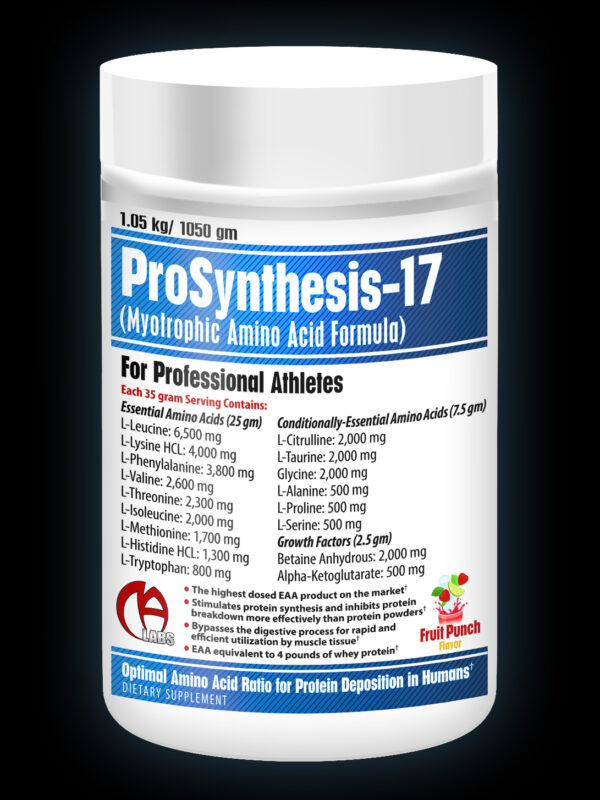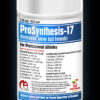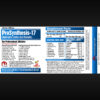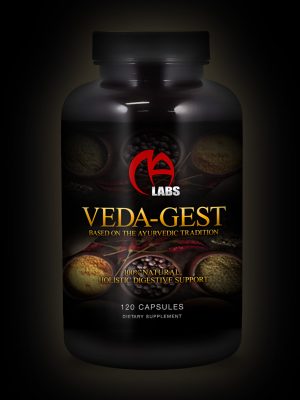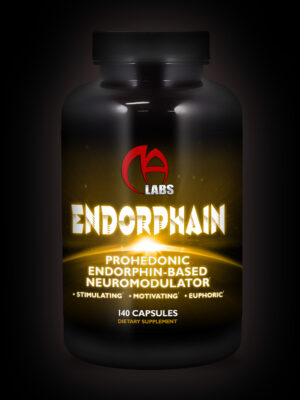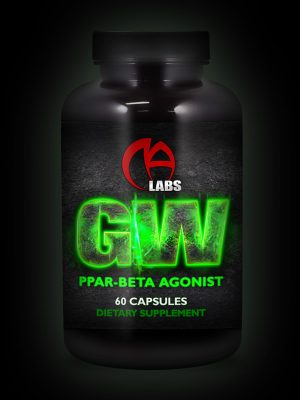Description
ProSynthesis-17
Frequently Asked Questions
1.)Is ProSynthesis-17 the most-effective EAA product in the world?
2.) Is ProSynthesis-17 the highest dosed EAA product in the world?
3.) Is ProSynthesis-17 a better value than other EAA products?
4.) Is ProSynthesis-17 more anabolic than whey protein or whole food?
5.) Is ProSynthesis-17 a better value than whey protein?
6.) Is ProSynthesis-17 more conducive to fat loss than whey protein?
7.) Is ProSynthesis-17 less likely to cause digestive upset than protein powders?
8.) I’ve noticed that many of today’s EAA products contain very low doses of tryptophan and especially methionine. Is this important?
9.) Does the body require EAAs at different ratios for building muscle tissue, as opposed to maintaining muscles tissue?
10.) If I were to double or triple the serving size of another EAA product, would I get the same results?
11.) Why does ProSynthesis-17 contain 6.5 grams of leucine per serving, rather than the standard 5 grams shown in studies to maximize
protein synthesis signaling?
12.) What are “Priming Amino Acids” and why are they critical in an EAA product?
13.) Why has Betaine been added to ProSynthesis-17?
14.) Why has Taurine been added to ProSynthesis-17?
15.) Why has Glycine been added to ProSynthesis-17?
16.) Why has Serine been added to ProSynthesis-17?
17.) Why has Alanine been added to ProSynthesis-17?
18.) Why has Proline been added to ProSynthesis-17?
19.) Why has Alpha-ketoglutarate been added to ProSynthesis-17?
20.) Why has Citrulline been added to ProSynthesis-17?
21.) Why has Vitamin D been added to ProSynthesis-17?
22.) Why has AstraGin been added to ProSynthesis-17?
1.) Question: Is ProSynthesis-17 the most effective EAA product on the market?
Answer: Yes. There are several reasons for this, one of which is the ability to induce a greater spike in plasma amino acid concentrations. By accomplishing this objective, the body enters a state known as “peak aminoacidemia”. This results in a more pronounced and prolonged increase in protein synthesis, as well as a more robust anti-catabolic effect. ProSynthesis-17 is also unique in that it initiates mTOR priming, rather than relying solely on mTOR activation (unlike nearly all other EAA products). By combining both priming and activating amino acids, the body’s muscle building machinery is ignited without the need for external assistance or having to rely on endogenous production. Even more importantly, ProSynthesis-17 contains a vastly superior amino acid profile, enabling every gram of EAAs to be used for their intended purpose. Muscle growth. Other benefits include increased amino acid bioavailability, enhanced nitric oxide production, and improved growth efficiency. A more in depth explanation of these benefits (as well as additional benefits) is provided throughout the rest of the Q & A.
2.) Question: Is ProSynthesis-17 the highest dosed EAA product in the world?
Answer: Yes. A recent market analysis shows that ProSynthesis-17 provides roughly 250%-800% more EAAs, per serving, than the competition. This is important, as the body’s ability to synthesize new tissue is directly dependent on the number of building blocks (e.g., essential amino acids) available for use. Each serving of ProSynthesis-17 provides a whopping 25 grams of EAAs, in addition to 10 grams of CEAAs & growth agents. No other product even comes close.
3.) Question: Is ProSynthesis-17 a better value than other EAA products?
Answer: Yes. ProSynthesis-17 provides more amino acids, at a better price, than any other product on the market. Each container of ProSynthesis-17 contains 1050 grams of total amino for less money than most companies charge for half that amount.
4.) Question: Is ProSynthesis-17 more anabolic than whey protein or whole-food?
Answer: Yes. Recent research shows that just 6 grams of EAAs stimulates protein synthesis to a greater degree than 30 grams of why protein. ProSynthesis-17 provides more than four times that dose of EAAs. Recent research also shows that EAAs improve performance, strength and fat loss more effectively than whey protein.
5.) Question: Is ProSynthesis-17 a better value than whey protein?
Answer: Yes. You would need to purchase roughly 4 pounds of whey protein in order to obtain the same amount of EAAs found in a single container of ProSynthesis-17. Considering the price of whey protein today, ProSynthesis-17 is certainly the more cost-effective option.
In terms of potency equivalents, each serving or ProSynthesis-17 contains the same amount of EAAs found in 60+ grams of whey protein or 65+ grams of protein from red meat, but that only tells part of the story. In reality, a single serving of ProSynthesis-17 is far more anabolic than either of those options. Why? The answer lies in the product’s rapidity of absorption.
Because ProSynthesis-17 is absorbed so quickly, there is a massive influx of amino acids into the bloodstream, causing the body to enter a state known as peak aminoacidemia. During this state, the body undergoes an incredible boost in protein synthesis, as well as an immediate cessation of protein breakdown. Protein powders, and especially whole food, simply cannot compete on the same level. Nothing else on the market even comes close.
6.) Question: Is ProSynthesis-17 more conducive to fat loss than whey protein?
Answer: Yes. A single serving of ProSyntheis-17 provides roughly 1/3rd fewer calories than an equivalent amount of EAAs from whey protein, while also providing zero fat and zero carbohydrates. In addition, research has demonstrated the ability of EAAs promote a greater reduction in adipose tissue (e.g., body fat) in comparison to whey protein.
7.) Question: Is ProSynthesis-17 less likely to cause digestive issues than protein powders?
Answer: Yes. ProSynthesis-17 provides instantized free-form amino acids. These amino acids require no digestion, but are immediately passed from the stomach to the small intestine, where they are absorbed almost instantly. Because free-form amino acids do not require digestion and are absorbed with near 100% efficiency, the likelihood of experiencing digestive difficulties, such as gas, nausea or bloating, is dramatically reduced.
8.) Question: I’ve noticed that many of today’s EAA products contain very low doses of tryptophan and especially, methionine. Is this important?
Answer: Yes! It’s extremely important! This is because the body requires all 9 EAAs in a set ratio in order to build muscle tissue. If the body runs out of even one of these amino acids, muscle growth stops dead in its tracks, rendering the remaining EAAs completely useless! Therefore, it makes sense to formulate an EAA product with the same amino acid ratio that the body uses to build muscle tissue.
Unfortunately, most of today’s EEA products do not do this. In fact, the amino acid ratio of most of these products is so poor, that up to 95% of the EAAs they provide are completely squandered (i.e., can NOT be used for muscle growth) unless you provide the body with additional methionine and tryptophan through supplementation or food!
Why would a company make an EAA product that can’t even stand on its own two feet? Well, I’m going to answer it for you right now and you probably won’t like the answer! Like many things in this industry, the answer comes down to profit! You see, amino acids like methionine and tryptophan are more difficult to flavor than others, so they sacrifice their product’s effectiveness for enhanced palatability, in the hope that you’ll buy their product instead of their competitor’s.
Of course, they don’t tell you this because it sounds bad…and it sounds bad because it is bad! But there is a 2nd reason why they hide this fact from you…and it’s because they think you’ll never know! They are acutely aware that it’s notoriously difficult, if not impossible, for most customers to measure exactly how much benefit their EAA product is providing. Therefore, most companies just focus on pleasing your palate, while selling you a very poorly formulated product. They think that if their product tastes even 10% better than the competition, that you’ll keep buying it without ever knowing you’re largely wasting your money.
So, how badly does the competition compromise their product’s effectiveness in order to increase profits?” More than you probably think. In fact, it’s so bad that you may not believe the answer without doing some research, but I’ll answer anyway. The truth is that most companies add only 1/10th to 1/50th of the methionine dose required in order to properly balance their product’s EAA ratio. Just look at the “supplement facts” section of these products and see for yourself. A typical serving size for these products is usually 8-10 grams. In order to provide a balanced ratio for this serving size, it requires about 500-800 mg of methionine. Yet, you will see doses ranging from 50 mg per serving, all the way down to a nearly non-existent 10 mg per serving. This means that the body will run out of methionine LONG BEFORE it can utilize the remaining EAAs. In order to give you an idea of how bad this actually is, let me put it this way. If a whole food protein source was this deficient in one of the mandatory 9 EAAs, scientists would categorize it as an incomplete protein. Yes, “incomplete”, as in UNABLE to build muscle tissue on its own! If this doesn’t alert you to the seriousness of the situation, I don’t know what will.
Here at MA Labs, this is something we will NEVER do. It goes against not only the company’s mission statement, but against every inclination I personally possess as a product formulator. We always prioritize results above all else and we believe most people demand the same. If not, there are plenty of other less effective EAA products on the market. With that said, you can rest assured that ProSynthesis-17 still tastes great!
9.) Question: Does the body require EAAs at different ratios for building muscle tissue, as opposed to maintaining muscles tissue?
Answer: Yes. However, rarely is any distinction ever made between the ratio of EAAs needed for muscle growth versus muscle maintenance. Therefore, even if a company doesn’t intentionally short you on methionine or tryptophan (which is less than 5% of all EAA products on the market), almost all of them have been formulated with an EAA ratio better suited for muscle maintenance rather than growth. In truth, I have yet to see ANY product that has taken both of these factors into account, aside from ProSynthesis-17, and believe me, I have searched!
10.) Question: If I were to double or triple the serving size of another EAA product (in order to consume the same amount of EAAs found in one serving of ProSynthesis-17), would I get the same results?
Answer: No…because even if you were to weigh out the same number of total grams found in a single serving of ProSythesis-17, you will still encounter the same problems mentioned above (e.g., poor amino acid ratio due to methionine and tryptophan deficiency, formulated for muscle tissue maintenance, etc.), but you would also encounter another problem. Leucine excess.
You see, most companies have elected to include leucine at optimal (or near optimal) doses, despite the small overall serving size. This is a good thing, as it enables the product to effectively stimulate protein synthesis signaling, despite containing a small amount of the other EAAs. If I were to describe this situation using an analogy, it would go something like this…
Let’s say you own a super-car (i.e., leucine), but you only fill it with a ¼ tank of gas (i.e., low doses of the other 8 EAAs). What’s going to happen? You’ll be able to reach high speeds, but not for very long. The point here is that most EAA products do a fairly good job of stimulating muscle growth, but they just don’t do so for very long. The body simply “runs out of gas”.
So, that is easy enough to understand, but what about the problem of “excess leucine”, mentioned above? By combining multiple servings of other EAA products, you’ll certainly end up with more total EAAs, but you’ll also end up consuming WAY MORE leucine than the body needs to optimize protein synthesis signaling. The end result is a LOT of wasted leucine. With most products providing roughly 1/3rd of their total weight in the form of Leucine (some contain as much as 50% leucine by weight), there is little incentive to consume multiple servings at once. Once you factor in the already poor amino acid ratio (due to methionine/tryptophan shortage), you end up flushing the MAJORITY of the product right down the toilet…literally!
And do I even need to mention the massively inflated cost of consuming multiple servings of other EAA products? On a gram for gram basis, ProSynthesis-17 is already a much more cost-effective option, so why pay more just to end up wasting most of your product? There is no world in which this makes sense. Of course, ProSynthesis-17 has been formulated with an optimal dose of Leucine in perfect proportion to its massive serving size!
11.) Question: Why does ProSynthesis-17 contain 6.5 grams of leucine per serving, rather than the standard 5 grams shown in studies to maximize protein synthesis signaling?
Answer: Great question! When consumed alone on an EMPTY stomach, 5 grams is all it takes to optimize protein synthesis signaling. However, when leucine is consumed in the presence of other amino acids (such as the other 8 EAAs), a portion of it fails to be absorbed due to a phenomenon known as competition for absorption. In order to remediate this shortcoming and ensure that protein synthesis signaling is optimized, ProSynthesis-17 has been formulated with 6.5 grams of leucine per serving.
12.) Question: What are “Priming Amino Acids” and why are they critical in an EAA product?
Answer: Before I can answer that question in a meaningful way, I first need to briefly address the role of mTOR in the body and how it is activated. MTOR, which is comprised of two distinct protein complexes, is the central regulator of muscle growth in the human body. There are many substances capable of activating mTOR, perhaps the most well known of which is the amino acid, leucine. This is one of the big reasons EAA products (all of which include leucine) have become so popular over the years. Not only are these products capable of stimulating protein synthesis via leucine-induced mTOR activation, but they also provide the building blocks (e.g., the other 8 EAAs) necessary for taking advantage of that signal.
Being able to activate mTOR through EAA supplementation is a huge benefit, but what if your EAA product wasn’t able to activate mTOR, despite containing copious amounts of leucine? Obviously, it wouldn’t be of much value, but is this something we even need to be concerned with? Yes.
You see, mTOR is initiated by an obligate two-step process known as Priming & Activating. These are two separate, distinct steps, which must be completed in order for mTOR to do its job (i.e., turn on the growth process). These two steps are regulated by two different groups of amino acids, known as priming amino acids and activating amino acids. Leucine itself is the primary “activating amino acid”, while other amino acids, such as methionine, arginine, glutamine, citrulline, etc., can also help activate mTOR (although to a much smaller degree). “Priming amino acids” include proline, serine, alanine and some other CEAAs (conditionally-essential amino acids).
Now, here’s the important part. If you don’t have at least one of these priming amino acids present at the time your EAA product is trying to activate mTOR, it will NOT be activated! It doesn’t matter how much leucine your EAA product contains. The body simply will NOT be able to activate mTOR and therefore, the other 8 EAAs will float around your bloodstream doing nothing…or be used for energy, rather than muscle growth. I’ll say it again. In the absence of at least one priming amino acid, your EAA product can NOT build muscle! This is not a controversial claim. It is a well-known fact easily confirmed by searching the following url: Amino Acids Regulate mTORC1 by an Obligate Two-step Mechanism – PubMed
As you might have guessed, ProSynthesis-17 includes a substantial dose of priming amino acid; four of them, to be exact. Each of these amino acids was selected not only for their ability to act as a primer, but because they provide additional, bodybuilding specific benefits that further enhance the muscle building effect of EAAs.
Note: If you are eating a well-rounded, protein rich diet throughout the day, you will likely have at least one of these priming amino acids present at the time your EAA product is consumed. However, if an EAA product is used first rise in the morning (after an all-night fast) or at any other time protein has not been consumed for a while, the absence of a priming amino acid can become a real issue.
13.) Question: Why has Betaine been added to ProSynthesis-17?
Answer: Widely regarded as one of today’s most effective ergogenic aides, betaine provides a host of beneficial effects directly applicable to those attempting improve both their appearance and performance. The evidence for its efficacy is undeniable, as it has been clinically validated—on numerous occasions—to provide measurable increases in lean body mass and strength, enhance overall physical performance, and decrease body fat in both trained and untrained individuals alike.
The manner in which betaine manifests these effects is manifold, one of which includes the ability to activate mTOR through a rather unique pathway. Unlike most mTOR activators, betaine does not perform this function through direct activation, nor through the manipulation of downstream targets. Rather, it does so through the inhibition of mTOR adverse mechanisms, such as SAMTOR binding. In short, here’s how it works…
- GATOR is an endogenous protein that activates mTOR.
- SAMTOR is an endogenous protein that stops the activation of mTOR by interfering with GATOR.
- S-adenosylmethionine (SAM) is a methyl donor that stops SAMTOR from interfering with GATOR.
- Betaine increases SAM levels, thereby preventing SAMTOR from interfering with GATOR, which, in turn, allows GATOR to activate mTOR.
In other words, betaine prevents the bad guy from inhibiting mTOR! But this is not betaine’s only benefit. It has also been clinically shown to: Increase IGF-1, increase growth hormone, increases testosterone, decrease cortisol, and decrease muscle lactate! That’s a pretty impressive list of benefits.
14.) Question: Why has Taurine been added to ProSynthesis-17?
Answer: From an athletic standpoint, taurine has traditionally been employed as an osmolytic agent in the prevention and/or alleviation of blood flow induced muscle pumps. However, many are unaware of its other, direct muscle building benefits. As the most abundant amino acid within muscle tissue, taurine is absolutely crucial in enabling the body to not only synthesize new tissue, but to perform to the best of its ability.
Some of taurine’s benefits include the promotion of protein synthesis and the proliferation of C2C12 myoblast cells through stimulation of the PI3K-ARID4B-mTOR pathway; a key regulator of muscle growth in mammals. Other evidence strongly suggests that taurine is critical in the differentiation of satellite cells via the Ca(2+) signaling pathway, thereby playing a key role in the recovery & growth process during the post-training recovery period.
Supplemental taurine has also been shown to reduce muscle inflammation and improve muscle strength in patients. This is no surprise, as taurine deficiency in skeletal muscle tissue is associated with incomplete muscular development, morphological abnormalities, decreased exercise abilities, and myofiber necrosis. Many scientists consider taurine to be so important in the regulation and function of muscle tissue that they have recommended it be classified as an EAA (essential amino acid), particularly during the early years of growth and development when muscle fiber maturation is essential. ProSynthesis-17 provides 2 full grams of taurine in every dose, thereby helping to ensure maximum recovery, growth, and performance.
15.) Question: Why has Glycine been added to ProSynthesis-17?
Answer: As one of the most underappreciated, but important conditionally-essential amino acids, glycine plays an important role in several aspects of the muscle building process. This is particularly true as it pertains to its interactions with leucine.
With leucine being the primary signaler of protein synthesis, it might sound like a good idea to take massive doses of this amino acid several times per day, but research shows otherwise. The reason here is simple. Desensitization. As the frequency of leucine supplementation escalates, the body’s response to its anabolic signal (as well as the overall anabolic response to EAAs, in general) begins to diminish. The end result is reduced efficacy of your EAA product.
One way to maintain the body’s anabolic response to leucine-EAAs, is through the co-administration of glycine, as glycine helps to restore and maintain the anabolic effect of leucine-EAAs.
Some other reasons to combine glycine with EAAs include: It’s ability to activate mTOR, its ability to inhibit catabolic pathways like MuRF1 and Atrogin-1, its ability to regulate stem cell & progenitor cell function, and its ability to enhance fat loss while protecting against muscle loss during periods of caloric restriction.
16.) Question: Why has Serine been added to ProSynthesis-17?
Answer: This little-acknowledged amino acid plays a fundamental role in activating the proliferation of muscle progenitor cells (MPCs) and muscle-specific adult stem cells (MuSCs). Why is this important? Hang with me for a minute and you’ll soon understand.
When we lift weights with sufficient intensity, the muscles experience a degree of injury. This kick-starts an incredibly complex process, part of which includes the rapid mobilization and expansion of what we call muscle progenitor cells (MPCs), as well as muscle-specific adult stem cells (MuSCs). The mobilization of these cells is absolutely crucial in the reparation (e.g., recovery) and adaptation (e.g., growth) of damaged muscle fibers.
However, this mobilization is dependent on the presence of extracellular serine (as well as glycine, which is also included in ProSynthesis-17). Research has repeatedly demonstrated that the restriction of serine during the post-training period results in reduced mobilization or even complete cell cycle arrest! In addition, research has also shown that that the endogenous production of this amino acid is insufficient to support post-training demands, thereby making dietary serine essential for optimizing muscle growth.
For this reason, serine has been included in the ProSynthesis-17 formula, ensuring that your body has everything it needs to optimize the recovery & growth process.
17.) Question: Why has Alanine been added to ProSynthesis-17?
Answer: Alanine has been added to ProSynthesis-17 for one simple reason—its ability to boost BCAA bioavailability. BCAAs make up a substantial portion of muscle tissue and play a key role in stimulating protein synthesis. Therefore, ensuring the optimal bioavailability of these amino acids (especially leucine) is an important consideration in the development of any EAA product.
18.) Question: Why has Proline been added to ProSynthesis-17?
Answer: The body’s requirement for proline in whole-body protein synthesis is the highest among all amino acids. It plays an important role in protein synthesis, wound healing, antioxidative reactions and immune responses, all of which are involved in the body’s response to weight training. In mammalian research, supplemental proline has been shown to improve feed efficiency, while enhancing growth beyond what the body is capable of achieving through de novo synthesis (i.e., endogenous production) alone, further supporting the need for supplemental proline during periods of high intensity training.
19.) Question: Why has Alpha-ketoglutarate been added to ProSynthesis-17?
Answer: Despite rarely being included in amino acid products, alpha-ketoglutarate provides an abundance of beneficial effects. Some of these include: the prevention of protein breakdown through modulation of the PHD3/ADRB2 pathway, the stimulation protein synthesis through activation of mTOR, the stimulation of muscle growth and fat loss via OXGR1-dependent adrenal activation, and an increase in protein deposition by enhancing the transport of amino acids through the small intestine.
20.) Question: Why has Citrulline been added to ProSynthesis-17?
Answer: Citrulline is one of the most popular amino acids is sports nutrition today, and for good reason. Not only does it stimulate growth via the P13/MAPK/4E-BP1 pathway, but it uniquely stimulates protein synthesis by reallocating mitochondrial fuel to the protein synthesis machinery. It has also been shown to upregulate IGF-1 and IGF-1 expression, increase growth hormone concentration and in numerous studies, improve physical performance in athletes.
Most commonly, citrulline is known for its ability to increase nitric oxide production, thereby resulting in greater muscle pumps, enhanced oxygenation and improved nutrient delivery. Lastly, citrulline helps to combat muscle breakdown via its anti-inflammatory and antioxidative effects in muscle tissue.
21.) Question: Why has Vitamin D been added to ProSynthesis-17?
Answer: Vitamin D, despite its relative lack of fanfare in the sport nutrition world, plays an integral role in the overall growth and maintenance in muscle tissue. As a steroid hormone itself, vitamin D exerts both anabolic and anticatabolic effects through multiple pathways.
Interestingly, clinical studies have shown that Vitamin D acts synergistically with leucine-EAAs to activate mTOR to a greater degree than leucine-EAAs alone. By itself, this is enough of a reason to supplement with Vitamin D, especially considering its cheap cost. Studies have also demonstrated the ability of vitamin D to enhance strength and physical performance in athletes, while deficiency of this vital nutrient has been shown to result in diminished growth, a loss of strength and mitochondrial dysfunction.
ProSynthesis-17 includes 2,000 iu of Vitamin D3 in every serving.
22.) Question: Why has AstraGin been added to ProSynthesis-17?
Answer: In my opinion, AstraGin should be a staple ingredient in every EAA product, as no other single ingredients has the potential to enhance their effectiveness at such a low out of pocket cost. In short, AstraGin boosts EAA bioavailability by enhancing the absorption of amino acids into the bloodstream…and not by a small margin, either. This one ingredient improves EAA efficiency unlike any other, making its inclusion a no-brainer. Any company that neglects to include AstraGin in their EAA product is dramatically reducing its effectiveness just to save a few pennies per serving.

